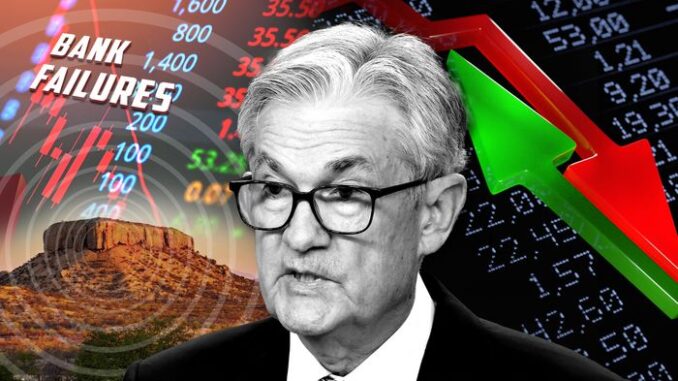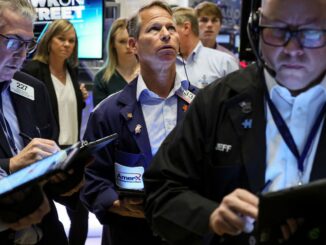
Some investors see a hard landing for the U.S. economy this year resulting from the sharply higher interest rates engineered by the Federal Reserve to quell inflation and tighter credit conditions in the wake of regional bank sector stress, while others note that consumer spending and employment growth remains healthy, but the Federal Reserve’s loan officer survey due this week may provide more clarity on which view is more accurate.
“The last two rate hikes were nuts, to be blunt,” said Edward Yardeni, president of Yardeni Research, in a phone interview. The Fed “could really cause a problem coming and going.”
Concerns still swirl around the banking industry after the failure of Silicon Valley, Signature Bank and First Republic Bank in the past two months and the bond market is expressing the view that the Fed will have to cut interest rates as a result, despite Fed Chair Jerome Powell pushing back on that notion on May 3, the day it announced a 10th straight increase in rates.
“He did his utmost to convince market participants that the Fed is not going to be lowering interest rates, but will probably keep them where they are for a while,” said Yardeni. “The market’s anticipating a hard landing.”
But “I’m anticipating a soft landing that will allow the Fed to maintain the fed-funds rate” at the current level possibly through the end of the year, said Yardeni. The federal-funds rate is now at a target range of 5% to 5.25%, after the central bank’s rate hike of a quarter point on May 3.
“If they just stop here,” he said, “all hope isn’t lost.”
Yardeni, who sees a 60% chance of a soft-landing scenario and a 40% probability of a hard landing, expects the stock market to be higher by year-end. In his view, October 12 marked the bear-market low for the S&P 500 index, which he said could finish 2023 at 4,600. That’s about 11% above Friday’s close.
Will S&P 500 Keep Climbing from its October Low?
The U.S. stock market ended sharply higher Friday, with the S&P 500 SPX, +1.85% closing at 4,136 for a year-to-date gain of 7.7%, according to FactSet data. But stocks were mostly down for the week, with the S&P 500 falling 0.8%, the Dow Jones Industrial Average DJIA, +1.65% sliding 1.2% and the technology-heavy Nasdaq Composite COMP, +2.25% eking out a 0.1% weekly gain.
“We’re cautious,” said David Bianco, chief investment officer for the Americas at DWS, in a phone interview. “We’re moderately underweight equities.”
Bianco expects the S&P 500 will be “pretty flat” this year, estimating a fair value of 3,700 – 4,000. He thinks the index may fall to the low end of that range amid worries over the U.S. debt-ceiling and the path of Fed policy, before moving back up to 4,000 at the end of 2023 “if all goes fairly well.”
According to Yardeni, the S&P 500 will probably keep fluctuating around 4,000 through the summer, as the market needs “to get a better handle on what the Fed is going to be doing for the rest of the year” and the debt-ceiling debate has to be resolved before the fast-approaching deadline.
The Fed has indicated for a while it wants to bring rates to a restrictive level and keep them there, he said. “I think the banking crisis confirms that they got there.”
Meanwhile, the Fed’s senior loan officer opinion survey on bank lending practices will be released on Monday. “It’s hard to imagine that it shows anything but credit conditions continuing to tighten,” said Yardeni. “It will certainly include responses reflecting the banking crisis.”
Bianco said he’s been keeping an eye on the availability and cost of credit as well as “how it affects the willingness of businesses to invest.”
Economy-wide recession?
The bond market seems to be counting on a recession of at least average magnitude taking care of the U.S. inflation problem, as yields have slid recently despite the Fed hiking rates, according to Bianco.
The yield on the two-year Treasury note TMUBMUSD02Y, 3.924% fell 14.4 basis points this past week to 3.920%, its largest weekly decline since the stretch ending March 17 based on 3 p.m. Eastern Time levels, according to Dow Jones Market Data. On March 12, the Fed announced an emergency program to help banks meet the needs of their depositors after Silicon Valley Bank’s sudden collapse.
Ten-year Treasury yields TMUBMUSD10Y, 3.434% dipped almost one basis point this past week to 3.445%, declining along with two-year yields for a second straight week, according to Dow Jones Market Data.
U.S. Treasury Yields fall recently
In Bianco’s view, the Fed won’t cut rates unless there’s a “significant, unmistakable recession of greater-than-average magnitude with rapid deterioration in the labor force.” He described an average U.S. recession as having a 2% peak-to-trough contraction in gross domestic product over about a year.
Bianco is expecting a “shallow” recession to begin some time in 2023. “To me, the most constructive outlook is the Fed not having to do anything for the rest of the year,” he said. Rate cuts by year-end would not come with “risk-friendly conditions,” warned Bianco. “If that occurs, get out of the way.”
Rolling recession?
There’s “a great deal of pessimism out there” about the U.S. economic outlook, according to Yardeni, who said he tends to be more “optimistic.”
He thinks the U.S. has been in “a rolling recession, where different industries have been hit at different times by recessionary pressures,” as opposed to an economy-wide contraction that many investors are fearing this year.
“We’ve been kind of rolling through one, without the kind of dire consequences that an economy-wide recession would have,” said Yardeni.
For example, the rolling recession hit the single-family housing market last year as the Fed began raising rates, but multi-family housing remained “quite strong,” he said. Then retailers saw a recession after being stuck with inventory following consumers’ “buying binge” for goods during the pandemic before shifting their spending to services.
“The labor market remains strong because the service economy has done really well,” he said.
The unemployment rate in the U.S. remains historically low, dipping to 3.4% in April, according to a report Friday from the U.S. Bureau of Labor Statistics. The U.S. economy added 253,000 jobs last month, exceeding the forecast from economists polled by The Wall Street Journal, while wages rose.
Investors will get a reading on April inflation next week, with data from the consumer-price index due out on Wednesday. The previous monthly measure from the consumer-price index showed that inflation in March was sticky.
“Sure, we’re off the highs, but it’s still too high for too long,” said Bianco.
Fed’s ‘credibility issue’
Yardeni sees the Fed having “this credibility issue that they’re obsessed about” after taking too long to raise rates to fight inflation. It was “an embarrassment to them that they let the inflation genie out of the bottle without responding faster,” he said. “Now I think they want to be tough,” said Yardeni, so “they’re going to do whatever it takes to bring inflation down.”
Meanwhile, fed-funds futures and the yield on the two-year Treasury note are “screaming that interest rates are going to be heading down over the next year,” said Yardeni. On Friday, traders in fed-funds futures were largely expecting the Fed to pause its interest-rate hikes at its June policy meeting, while betting on rate cuts in the second half of the year, according to the CME FedWatch Tool.
“Financial stability concerns are going to be an issue at some point, and there is going to be some sort of tightening in credit conditions and standards,” said John Madziyire, head of U.S. Treasurys and TIPS at Vanguard Group in a phone interview. He expects “the Fed is close to the end” of its rate hiking cycle.
‘Powell’s Plateau’
Yardeni says his estimation of a 40% chance of a hard landing acknowledges he has perceived the Fed could break something in the financial system with its aggressive rate increases. The regional-bank failures in mid-March and the start of May seem signs of the Fed having finally broken something, but the central bank continued raising rates later that month and again this past week to fight inflation.
The Fed has done “a pretty good job” containing the banking crisis, partly through its emergency bank term funding program created in mid-March, Yardeni said. He expects the central bank will now pause its rate hikes but might not have to cut them this year as an economy-wide recession may not be imminent.
“They’re going to try and achieve Powell’s plateau,” potentially keeping the Fed’s benchmark rate at the current level for a while, he said. “I think that overtime, that will, in fact, help to bring inflation down without causing a recession.”
Source: www.marketwatch.com
ENB
Sandstone Group



